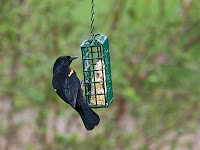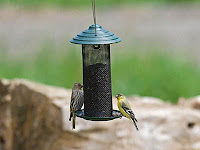 New interpretive plant signs in the upland area, Jackson Bottom Wetlands Preserve, Hillsboro, Oregon on April 21, 2010 by Greg Gillson.
New interpretive plant signs in the upland area, Jackson Bottom Wetlands Preserve, Hillsboro, Oregon on April 21, 2010 by Greg Gillson.April showers bring... migrants!
Lots of new birds arrived each day this week at Jackson Bottom Wetlands Preserve in Hillsboro, Oregon.
A locally rare migrant MACGILLIVRAY'S WARBLER was present on April 26. That day a YELLOW WARBLER was reported. ORANGE-CROWNED WARBLERS, WARBLING VIREOS, VAUX'S SWIFTS, and CLIFF SWALLOWS increased in numbers this week.
Both VIRGINIA RAILS and SORAS were heard calling in the marsh this week. An AMERICAN BITTERN was obvious at Kingfisher Marsh on APRIL 23.
GREATER WHITE-FRONTED GEESE migrated overhead starting on April 27. The first BLUE-WINGED TEAL of spring was spotted on April 23.
The pale gray PEREGRINE FALCON that has been seen every few days for the past month or so showed up several times during the week. A dark immature stooped on shorebirds over the mudflats of the Gene Pool on April 29. Eight immature BALD EAGLES were seen chasing an OSPREY that carried a fish on April 25. The nesting BALD EAGLES began bringing small prey items to the nest, so the egg(s) must have hatched about April 25.
Shorebird migrants included the first SPOTTED SANDPIPERS of spring on April 26. Two SOLITARY SANDPIPERS were present on April 28. Several other shorebird species arrived this week, the peak of their spring migration.
Jackson Bottom Wetlands Preserve is located at 2600 SW Hillsboro Hwy, Hillsboro, Oregon.
Greater White-fronted Goose
Cackling Goose
Canada Goose
Wood Duck
Gadwall
Mallard
Blue-winged Teal
Cinnamon Teal
Northern Shoveler
Green-winged Teal
Ring-necked Duck
Lesser Scaup
Bufflehead
Hooded Merganser
Ruddy Duck
Ring-necked Pheasant
Double-crested Cormorant
American Bittern
Great Blue Heron
Bald Eagle
Northern Harrier
Sharp-shinned Hawk
Cooper's Hawk
Red-tailed Hawk
American Kestrel
Peregrine Falcon
Virginia Rail
Sora
American Coot
Killdeer
Spotted Sandpiper
Solitary Sandpiper
Greater Yellowlegs
Least Sandpiper
Dunlin
Long-billed Dowitcher
Wilson's Snipe
Rock Pigeon
Mourning Dove
Vaux's Swift
Anna's Hummingbird
Rufous Hummingbird
Belted Kingfisher
Downy Woodpecker
Northern Flicker
Warbling Vireo
Steller's Jay
Western Scrub-Jay
American Crow
Common Raven
Tree Swallow
Violet-green Swallow
Northern Rough-winged Swallow
Cliff Swallow
Barn Swallow
Black-capped Chickadee
Bushtit
White-breasted Nuthatch
Bewick's Wren
Marsh Wren
Ruby-crowned Kinglet
American Robin
European Starling
Orange-crowned Warbler
Yellow Warbler
Yellow-rumped Warbler
Black-throated Gray Warbler
MacGillivray's Warbler
Common Yellowthroat
Wilson's Warbler
Spotted Towhee
Savannah Sparrow
Song Sparrow
White-crowned Sparrow
Golden-crowned Sparrow
Red-winged Blackbird
Brown-headed Cowbird
House Finch
Pine Siskin
Lesser Goldfinch
American Goldfinch
Evening Grosbeak


























